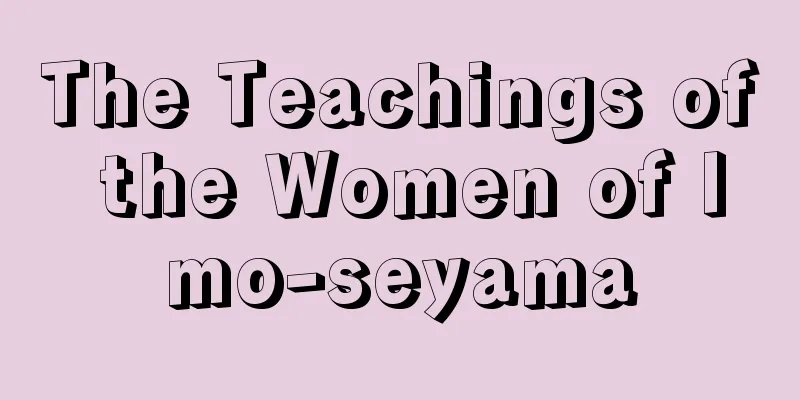The Teachings of the Women of Imo-seyama

|
Joruri Gidayubushi. A collaboration between Chikamatsu Hanji, Matsuda Baku, Sakai Zenpei, Chikamatsu Tounan, and Miyoshi Shoraku. A period piece. Five acts. First performed in January 1771 (Meiwa 8) at the Takemotoza Theater in Osaka. This work weaves an old legend from the Yamato region into the story of Fujiwara Kamatari's subjugation of Soga no Iruka. It was a hit piece during the revival of puppet theater, and was adapted into a kabuki play in the same year, becoming one of the most popular kyogen plays. First stage (Emishyakata) - Soga no Iruka pretends to admonish his wicked father, Emishi, but when this ends in self-destruction, he reveals his rebellion and aims to take the throne for himself. Second stage (Shibaroku Residence) - Iruka has the magical power of immortality, but his weakness is that he loses his true identity when he mixes the blood of a black-clawed deer with the blood of a jealous woman and pours it into a deer whistle and blows it. So the hunter Shibaroku, who is actually Genjo Taro, a vassal of the Fujiwara clan, breaks the taboo and shoots a deer. Third Act (Yoshino River) - Koganosuke, the son of Daihanji Kiyozumi, the lord of Seyama, Yamato Province, and Hinadori, the daughter of Sadaka (or Sadataka), the consort of Dazai of Imoyama, are in love, but due to the discord that has existed for generations, they are unable to speak to each other intimately. However, when Iruka orders the Daihanji to have his son serve and Sadaka to offer his daughter as a concubine as a sign of submission, Koganosuke begs for forgiveness for his righteousness and chastity, and Hinadori is killed by her mother, and both die while praying for the safety of their lovers. The discord between their parents is resolved, and they both swear to cooperate in defeating Iruka, and Sadaka places his daughter's head on a doll's accessory and casts it down the river, giving her as a bride to the Daihanji. Fourth Act (Cedar Sake Shop, Journey of Love and Hemp Ring, Palace) - While waiting for an opportunity to marry Tankai, the son of Kamatari, disguised as a horse-drawn hat-wearing horse in the village of Miwa, he falls in love with Omiwa, the daughter of a cedar sake shop, and Tachibana-hime, Iruka's younger sister. Tankai and Omiwa both tie hemp ring threads to the hem of the princess's clothes, and they follow them to the palace on Mikasayama. Enraged by jealousy, Omiwa is stabbed by a fisherman named Fukashichi, who has come to the palace as an emissary of Kamatari, but is actually Kanawa Goro. When Omiwa learns that the blood of a woman with a suspicious appearance is needed to defeat Iruka, she dies happy to be of use to her lover, Tankai. Iruka loses his magical powers thanks to the deer flute, and is defeated by Kamatari and his men. With its grand concept, exquisite writing, and dazzling stage techniques, it is a masterpiece representative of court plays. "Yoshinogawa" is also called "The Mountain Stage," and is filled with sad, poetic sentiment in a gorgeous scene of cherry blossoms in full bloom. Since its premiere, it has been performed as a dialogue in Bunraku puppet theater, and in Kabuki it is famous for its use of both hanamichi (walkways). "Goten" is an unusual piece with a fisherman and a town girl appearing in a nobleman's mansion, and it also well portrays the boldness of Shark Seven and the girlish heart of Omiwa, and it has been performed many times in particular. [Toshiaki Matsui] Source: Shogakukan Encyclopedia Nipponica About Encyclopedia Nipponica Information | Legend |
|
浄瑠璃義太夫節(じょうるりぎだゆうぶし)。近松半二、松田ばく、栄善平(さかいぜんぺい)、近松東南(とうなん)、三好松洛(みよししょうらく)合作。時代物。5段。1771年(明和8)1月大坂・竹本座初演。藤原鎌足(かまたり)の蘇我入鹿(そがのいるか)討伐に、大和(やまと)地方の古伝説を織り込んだ作。人形芝居中興の当り作で、同年歌舞伎(かぶき)に移され、屈指の人気狂言になった。 初段(蝦夷館(えみしやかた))―蘇我入鹿は、無道な父蝦夷をいさめるとみせ、これが自滅すると、自分が帝位をねらう反逆を現す。二段(芝六(しばろく)住家)―入鹿は不死身の魔力をもつが、爪黒(つまぐろ)の鹿(しか)の血と疑着(ぎちゃく)(嫉妬(しっと))の相ある女の血を混ぜ鹿笛に注いで吹くと正体を失うのが弱点なので、猟師(りょうし)芝六、実は藤原家の臣玄上(げんじょう)太郎は禁制を犯して鹿を射る。三段目(吉野川)―大和国背山(せやま)の領主大判事(だいはんじ)清澄(きよずみ)の息子久我之助(こがのすけ)と、妹山(いもやま)の大宰(だざい)の後室定香(さだか)(または定高(さだか))の娘雛鳥(ひなどり)は、恋仲なのに、親代々の不和のため、親しく語ることもできない。しかし、入鹿から、服従のしるしに、大判事は息子を出仕させ、定香は娘を側女(そばめ)として差し出すことを命令されると、義と操(みさお)のため久我之助は切服、雛鳥も母の手にかかり、互いに恋人の無事を祈りつつ死ぬ。親同士の不和は解け、ともに入鹿討伐への協力を誓い、定香は娘の首を雛道具にのせて川へ流し、大判事のもとへ嫁入りさせる。四段目(杉酒屋、道行恋苧環(みちゆきこいのおだまき)、御殿)―鎌足の息淡海(たんかい)は、三輪(みわ)の里で烏帽子折(えぼしおり)求馬(もとめ)に身をやつして機をうかがううち、杉酒屋の娘お三輪(みわ)と入鹿の妹橘姫(たちばなひめ)に恋い慕われる。淡海は姫の裾(すそ)に、お三輪も淡海の裾にそれぞれ苧環の糸をつけ、あとを追って三笠山(みかさやま)の御殿へたどり着く。嫉妬に逆上したお三輪は、鎌足の使者として御殿にきていた漁師鱶七(ふかしち)、実は金輪(かなわ)五郎に刺される。入鹿退治に必要な疑着の相ある女の生き血入用のためと知ったお三輪は、恋人淡海に役だつことを喜んで死ぬ。鹿笛によって入鹿は魔力を失い、鎌足たちに征伐される。 雄大な構想と文章の妙、絢爛(けんらん)たる舞台技巧などで、王朝物を代表する名作である。「吉野川」は「山の段」ともよばれ、桜花爛漫(らんまん)の華やかな場面に哀切な詩情があふれる。人形浄瑠璃では初演以来掛合いで演じられ、歌舞伎では両花道を使う演出で有名である。「御殿」は高貴の館に漁師や町娘の登場する趣向が奇抜で、鱶七の豪快味やお三輪の娘心もよく描かれ、上演回数はことに多い。 [松井俊諭] 出典 小学館 日本大百科全書(ニッポニカ)日本大百科全書(ニッポニカ)について 情報 | 凡例 |
<<: Feeling of heavy stomach - Imotarekan
Recommend
"Palace Guell" - Guell Tei
He combined the rational development of Gothic ar...
Iwai Kumesaburo (3rd generation)
...It is a mixture of the childish innocence of c...
Renewable resources
… Resources can also be viewed from another angle...
Kusuko Otsuka - Kusuko Otsuka
Year of death: November 9, 1910 (Meiji 43) Year of...
Imbe Shrine
Located in Nikenyacho, Tokushima City. It enshrin...
Kyogokudono - Kyogokudono
⇒Matsumaru-dono Source: Kodansha Digital Japanese ...
Edo Libra - Edo Hakariza
〘Noun〙 During the Edo period, this office was resp...
Red rhododendron - Red rhododendron
...Akebono azaleas have five leaves that grow in ...
Anti-airport movement - Kuukouhantainudou
...As a result, in any country, political forces ...
Nothingness (English)
Strictly speaking, "nothing" should be ...
Boar's Botamochi - Boar's Botamochi
...Rice cakes made on the day of the boar in the ...
Ravenala guianensis (English spelling) Ravenalaguianensis
…Because of its beautiful leaf shape, it is often...
Active history - Katsurekimono
Katsureki means "live history" and refer...
Caryophyllaceae
...Also, species with waxy substances on their st...
Ibuki Island
It is an isolated island located in the Hiuchi Na...









